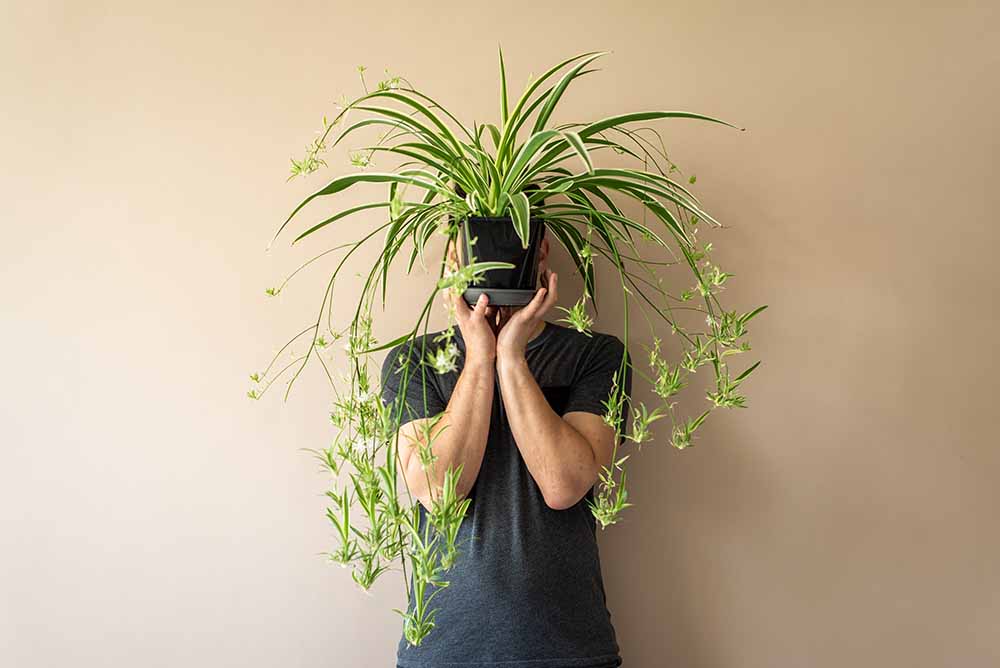
A home full of plants doesn’t just make a great background for social media posts – it can also be good for you. Research has shown that having greenery in your living space can have all kinds of health benefits, particularly when it comes to your mental health and mood. Despite their benefits for you, however, many common houseplants may pose a danger to curious pets who might want to nibble on their leaves. For that reason, when you introduce a new plant (or a new pet) to your home, it’s best to make sure that your plant babies and fur babies are safe from each other.
These 10 popular varieties of houseplants are ready to safely add foliage to your living space.
1. Spider plant 2. Air plant 3. African violet 4. Boston fern 5. Orchid 6. Staghorn fern 7. Christmas cactus 8. Baby rubber plant 9. Prayer plant 10. Parlour palm
1. Spider plant
This is one of the most popular of the hanging plants, partly because it’s extremely hard to kill, and partly because it produces small, spider-like mini plants (called pups) which are easy to propagate. Not only do spider plants look nice, they are also believed to have air-cleaning properties. For best results, place in bright indirect sunlight and re-pot annually.
2. Air plant
Among the more unusual indoor plants, air plants get their name from the fact that they get their nutrients from the air, not from the soil. As such, they are remarkably resilient and easy to grow indoors, even in rooms with little natural light. Most air plants require regular watering or misting, but because there are hundreds of varieties make sure to find out how to care for whichever ones you have.
3. African violet
Known for their fuzzy leaves and cheerful clusters of white and purple flowers, these common houseplants are native to the jungles of East Africa. While they are perfectly safe for both cats and dogs, their delicate leaves and stems can easily be damaged by an errant nose or paw, so this is one to keep out of reach if possible.
4. Boston fern
While it’s been a popular houseplant for more than a century, the history of the humble fern goes back more than 100 million years before dinosaurs roamed the earth. When keeping a Boston fern at home, make sure to put it somewhere bright but not in direct sunlight (which will scorch its delicate leaves). Since ferns evolved to thrive in humid, wet forests, make sure to mist regularly and keep the soil damp.
5. Orchid
There are more than 25,000 species of orchids on the planet, and their bright, dramatic blooms make them a favourite house plant. While they have a reputation for being fussy, orchids don’t need much more attention than other flowering house plants. Place them in bright, indirect light and water once or twice a week.
6. Staghorn fern
In case its unusual looks didn’t tip you off, this is not your average fern. Instead of living in the dirt like most of its cousins, the staghorn fern likes to make its home in the forks of trees and other cozy nooks, and can live happily without soil. Better yet, it can be mounted on the wall like its namesake antlers.
7. Christmas cactus
With their unusual spiky leaves and bursts of pink and red flowers, it’s no wonder the Christmas cactus has become so popular. It’s also remarkably easy to care for, preferring bright indirect light and humidity (bathrooms and kitchens are great spots). Better still, unlike other forms of cacti, these don’t have spines to irritate curious pets and accident-prone humans alike.
8. Baby rubber plant
While rubber plants are toxic to dogs and cats, baby rubber plants are not, so make sure you’ve got the correct one before you bring it home. Unlike the big, broad leaves of a rubber plant, a baby rubber plant (Peperomia obtusifolia) has small, round leaves with a fleshy texture.
9. Prayer plant
Also called the zebra plant for its stripy leaves, these handsome house plants can grow up to 1 metre in height, and live happily under a variety of conditions indoors. For best results, choose a bright spot free of drafts, keep the soil wet in spring and summer, and let it dry out completely between waterings in the winter months.
10. Parlour palm
A high return of greenery on minimal investment of care makes this plant a favourite. With big, dramatic fronds and few requirements other than indirect light and occasional watering, the parlour palm is a great way to safely add foliage to your space.
Jeremy Freed is a freelance writer and editor based in Toronto. His writing about fashion, travel, food and design appears in Sharp, Harry and re:Porter magazines, among many others.